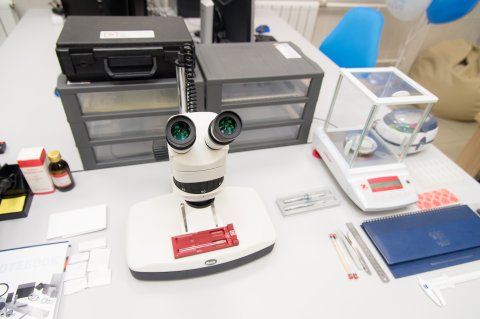The SUSU Laboratory of Functional Materials was established at the Nanotechnology Research and Education Centre in 2018. At present, the laboratory conducts research in the field of condensed matter physics, magnetism, metals and alloys, as well as studies new functional materials.
The fields of research of the new laboratory are related to developing nature-like technologies of synthesis of new functional materials; to creation of tailor-made magnetic materials with the shape memory effect; to studying extraterrestrial materials; as well as elaborating of a fundamentally new method of natural gas liquefaction based on magnetic cooling; and more.
In the field of magnetic materials engineering, the Laboratory of Functional Materials of the Nanotechnology Research and Education Centre develops two promising projects: engineering of new materials to be used in the technology of natural gas liquefaction based on the magnetocaloric effect, and engineering of new magnetically hard materials for non-rare-earth based permanent magnets.
The first field is an international German-Russian project, which has received support from the Russian Science Foundation (RSF) on behalf of Russia and from Helmholtz Association on behalf of Germany. The research is carried out jointly with Darmstadt University of Technology, Germany.
“Natural gas is one of the main energy sources, both today and in the foreseeable future. The trend of producing and consuming this type of energy increases monotonically for all the market segments, including natural gas, hydrogen, oxygen, nitrogen, etc. To store and transport this type of energy, liquefaction is required, but this process needs complicated energy-intensive compressor devices operated at cryogenic temperatures (at temperatures below 150 K, the efficiency of liquefaction through the use of traditional methods is quite low). At the same time, there exists a fundamentally different approach to gas liquefaction as a way to store the future energy — it is the technology of magnetic cooling. Taking into consideration the recent progress in the engineering of superconducting magnets with magnetic fields of up to 15‒22 T, this type of cooling at cryogenic temperatures can lead to a revolution in the technology of gas liquefaction,” notes Head of the Laboratory of Functional Materials Dmitry Bataev.
At present, there is a wide selection of various magnetic materials, with significant magnetocaloric effect in the temperature range from 15 to 150 K. It is expected that in the fields of superconducting magnets, the magnetocaloric effect will amount not to a few degrees (like in case of low and moderate magnetic fields), but to dozens of degrees. All of that allows to efficiently liquefy almost any natural gas using one and the same cooling machine. Therefore, the ultimate goal of the project is the complex adaptation of the technology of magnetic cooling to liquefaction of natural gas and hydrogen through using high magnetic fields of up to 20 T.
The second project aims at engineering of new magnetically hard materials for non-rare-earth based permanent magnets. It is carried out at the university’s own expenses; but once positive results of the preliminary research and development work are obtained, it is planned to receive the funding from Russian Science Foundation. Following the research results over the period from 2018 through 2021, the laboratory staff members are planning on publishing 45 papers in top-rated scientific journals (Q1/Q2).




